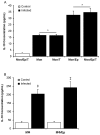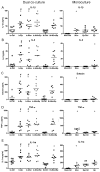Human bladder uroepithelial cells synergize with monocytes to promote IL-10 synthesis and other cytokine responses to uropathogenic Escherichia coli
- PMID: 24155979
- PMCID: PMC3796480
- DOI: 10.1371/journal.pone.0078013
Human bladder uroepithelial cells synergize with monocytes to promote IL-10 synthesis and other cytokine responses to uropathogenic Escherichia coli
Abstract
Urinary tract infections are a major source of morbidity for women and the elderly, with Uropathogenic Escherichia coli (UPEC) being the most prevalent causative pathogen. Studies in recent years have defined a key anti-inflammatory role for Interleukin-10 (IL-10) in urinary tract infection mediated by UPEC and other uropathogens. We investigated the nature of the IL-10-producing interactions between UPEC and host cells by utilising a novel co-culture model that incorporated lymphocytes, mononuclear and uroepithelial cells in histotypic proportions. This co-culture model demonstrated synergistic IL-10 production effects between monocytes and uroepithelial cells following infection with UPEC. Membrane inserts were used to separate the monocyte and uroepithelial cell types during infection and revealed two synergistic IL-10 production effects based on contact-dependent and soluble interactions. Analysis of a comprehensive set of immunologically relevant biomarkers in monocyte-uroepithelial cell co-cultures highlighted that multiple cytokine, chemokine and signalling factors were also produced in a synergistic or antagonistic fashion. These results demonstrate that IL-10 responses to UPEC occur via multiple interactions between several cells types, implying a complex role for infection-related IL-10 during UTI. Development and application of the co-culture model described in this study is thus useful to define the degree of contact dependency of biomarker production to UPEC, and highlights the relevance of histotypic co-cultures in studying complex host-pathogen interactions.
Conflict of interest statement
Figures







Similar articles
-
Rapid Bladder Interleukin-10 Synthesis in Response to Uropathogenic Escherichia coli Is Part of a Defense Strategy Triggered by the Major Bacterial Flagellar Filament FliC and Contingent on TLR5.mSphere. 2019 Nov 27;4(6):e00545-19. doi: 10.1128/mSphere.00545-19. mSphere. 2019. PMID: 31776239 Free PMC article.
-
Enhanced uropathogenic Escherichia coli-induced infection in uroepithelial cells by sugar through TLR-4 and JAK/STAT1 signaling pathways.J Microbiol Immunol Infect. 2021 Apr;54(2):193-205. doi: 10.1016/j.jmii.2019.05.008. Epub 2019 Jun 19. J Microbiol Immunol Infect. 2021. PMID: 31296484
-
Intramacrophage survival of uropathogenic Escherichia coli: differences between diverse clinical isolates and between mouse and human macrophages.Immunobiology. 2011 Nov;216(11):1164-71. doi: 10.1016/j.imbio.2011.05.011. Epub 2011 May 24. Immunobiology. 2011. PMID: 21802164
-
The glycobiology of uropathogenic E. coli infection: the sweet and bitter role of sugars in urinary tract immunity.Immunology. 2021 Sep;164(1):3-14. doi: 10.1111/imm.13330. Epub 2021 May 4. Immunology. 2021. PMID: 33763853 Free PMC article. Review.
-
Host-pathogen checkpoints and population bottlenecks in persistent and intracellular uropathogenic Escherichia coli bladder infection.FEMS Microbiol Rev. 2012 May;36(3):616-48. doi: 10.1111/j.1574-6976.2012.00339.x. FEMS Microbiol Rev. 2012. PMID: 22404313 Free PMC article. Review.
Cited by
-
Curli of Uropathogenic Escherichia coli Enhance Urinary Tract Colonization as a Fitness Factor.Front Microbiol. 2019 Sep 3;10:2063. doi: 10.3389/fmicb.2019.02063. eCollection 2019. Front Microbiol. 2019. PMID: 31551993 Free PMC article.
-
Strategies to Tackle Antimicrobial Resistance: The Example of Escherichia coli and Pseudomonas aeruginosa.Int J Mol Sci. 2021 May 6;22(9):4943. doi: 10.3390/ijms22094943. Int J Mol Sci. 2021. PMID: 34066555 Free PMC article. Review.
-
Involvement of NLRP3 and NLRC4 Inflammasome in Uropathogenic E. coli Mediated Urinary Tract Infections.Front Microbiol. 2019 Sep 3;10:2020. doi: 10.3389/fmicb.2019.02020. eCollection 2019. Front Microbiol. 2019. PMID: 31551961 Free PMC article.
-
Pathogenesis of Streptococcus urinary tract infection depends on bacterial strain and β-hemolysin/cytolysin that mediates cytotoxicity, cytokine synthesis, inflammation and virulence.Sci Rep. 2016 Jul 7;6:29000. doi: 10.1038/srep29000. Sci Rep. 2016. PMID: 27383371 Free PMC article.
-
Are you experienced? Understanding bladder innate immunity in the context of recurrent urinary tract infection.Curr Opin Infect Dis. 2015 Feb;28(1):97-105. doi: 10.1097/QCO.0000000000000130. Curr Opin Infect Dis. 2015. PMID: 25517222 Free PMC article. Review.
References
-
- Foxman B (2002) Epidemiology of urinary tract infections: incidence, morbidity, and economic costs. Am J Med 113 Suppl 1A: 5S-13S. doi:10.1016/S0002-9343(02)01054-9. PubMed: 1211386612601337. - DOI - PubMed
-
- Ipe DS, Sundac L, Benjamin WH Jr, Moore KH, Ulett GC (2013) Asymptomatic bacteriuria: prevalence rates of causal microbes, etiology of infection in different patient populations, and recent advances in molecular detection. FEMS Microbiol Lett 346: 1-10. doi:10.1111/1574-6968.12204. PubMed: 23808987. - DOI - PubMed
Publication types
MeSH terms
Substances
LinkOut - more resources
Full Text Sources
Other Literature Sources
Molecular Biology Databases

